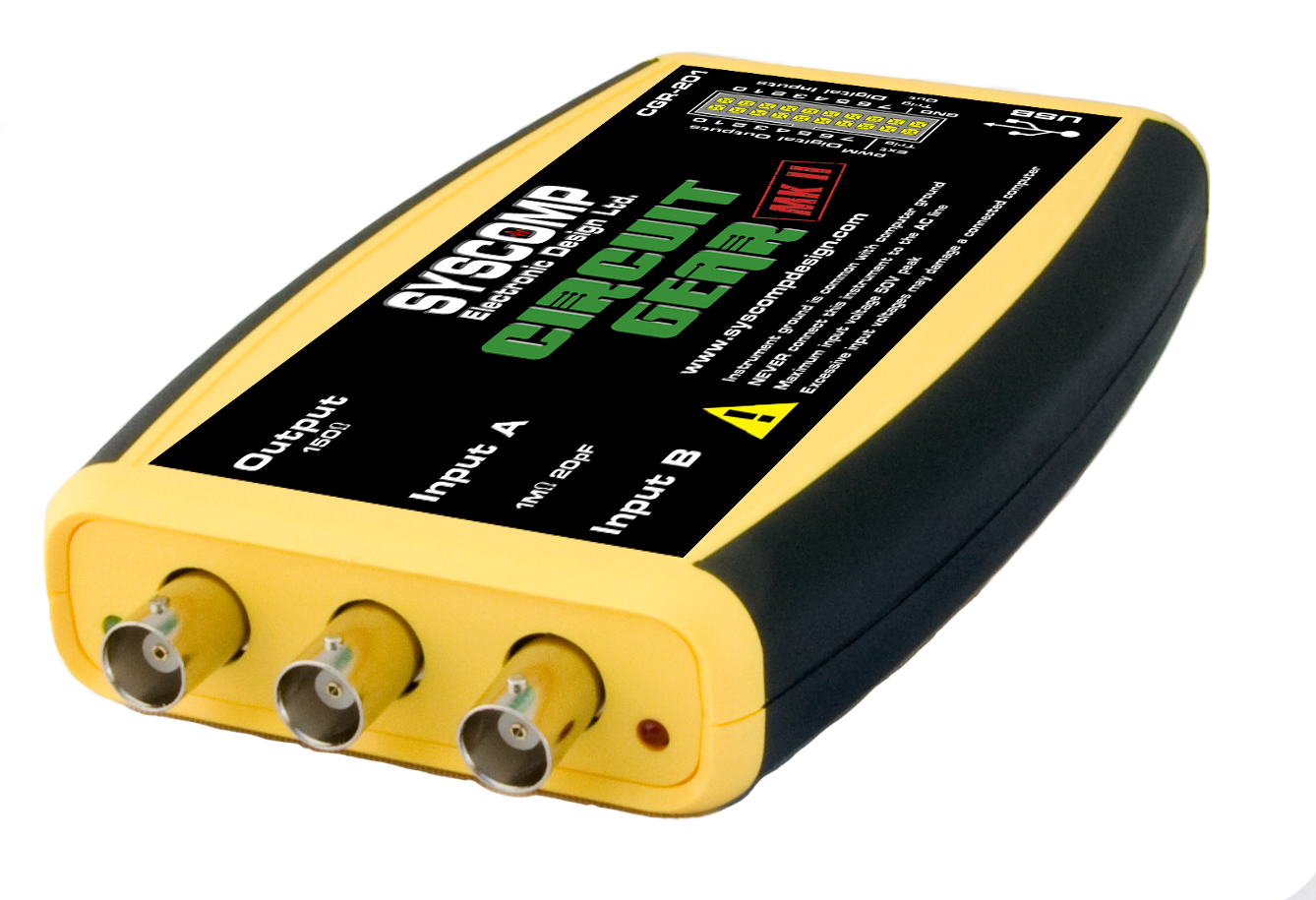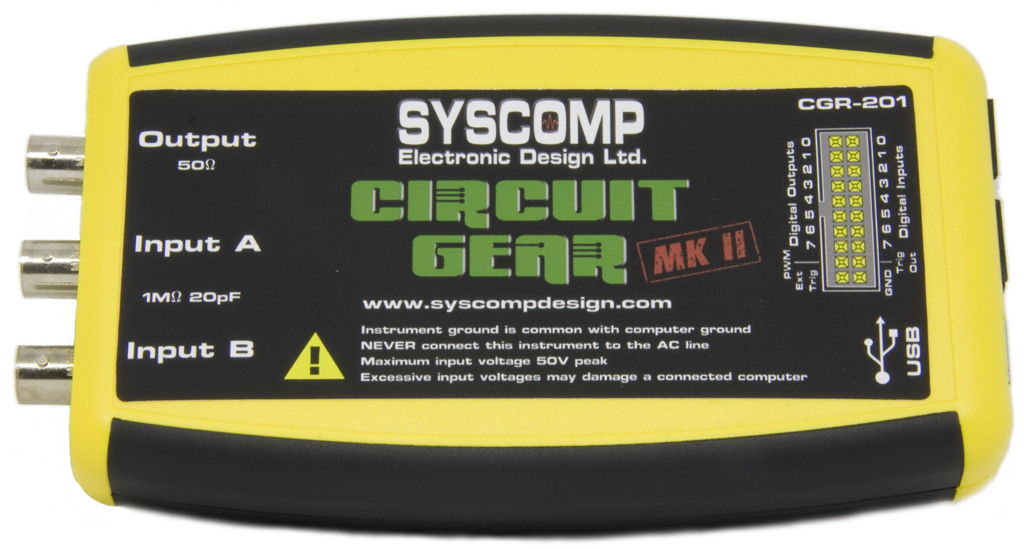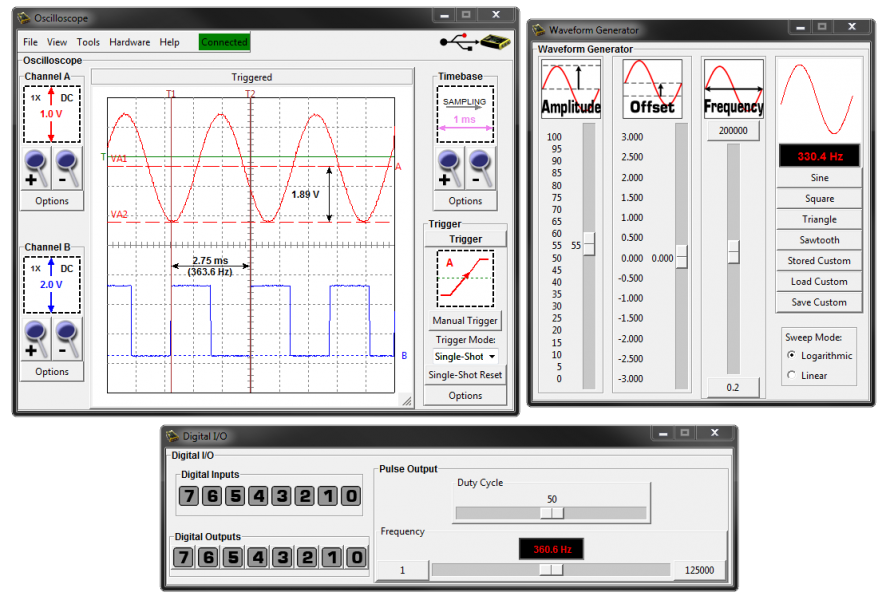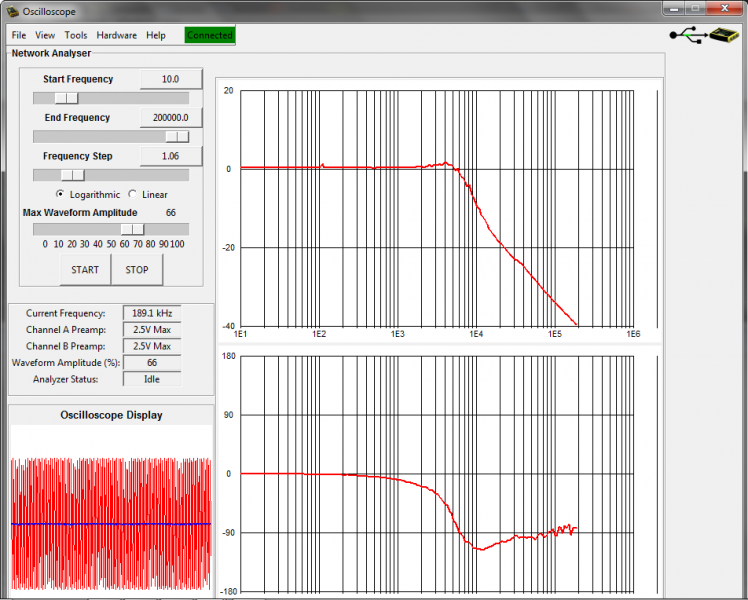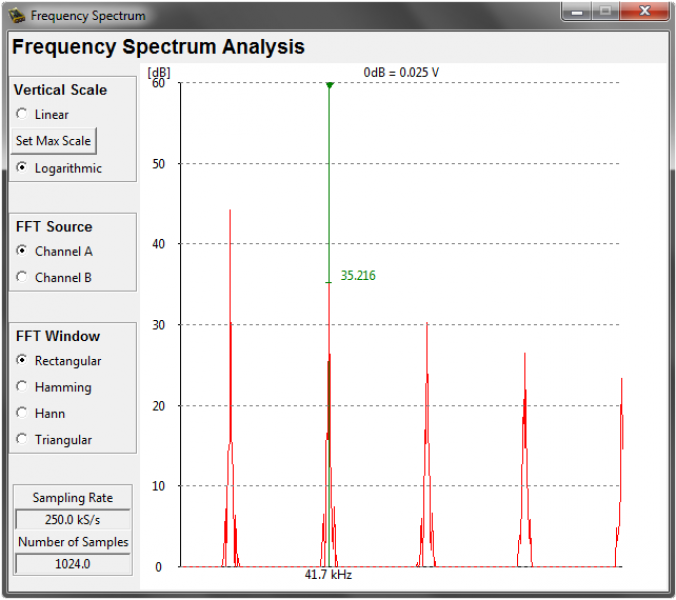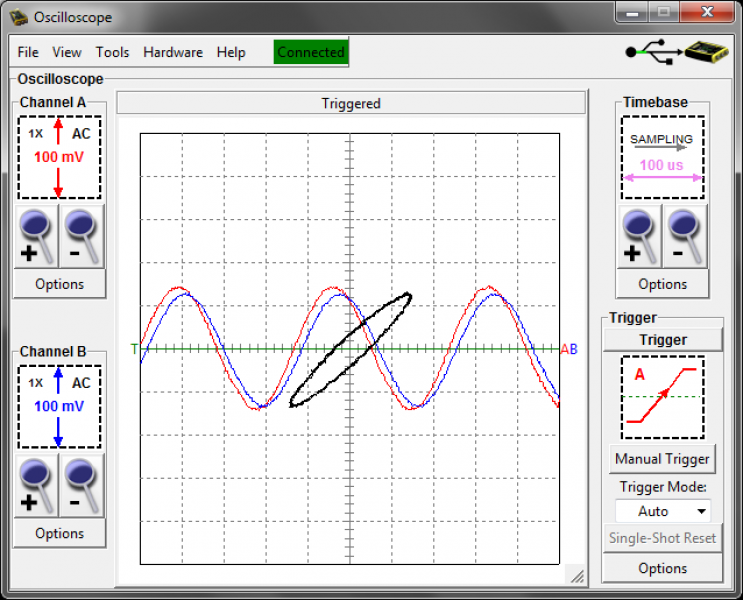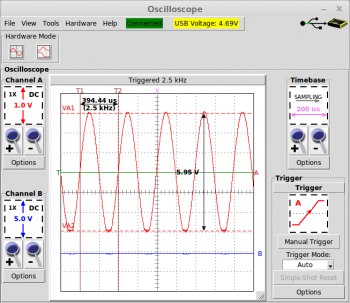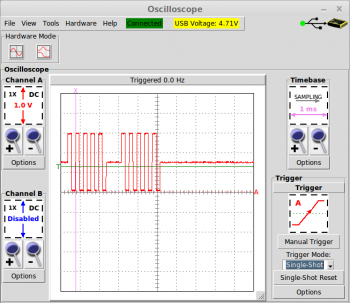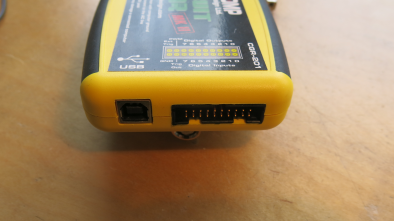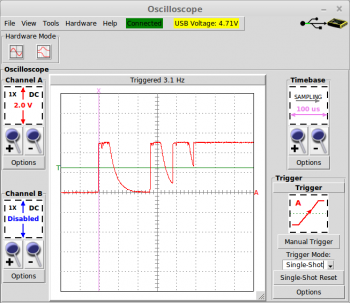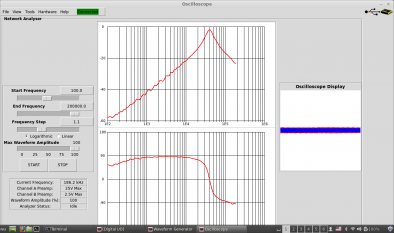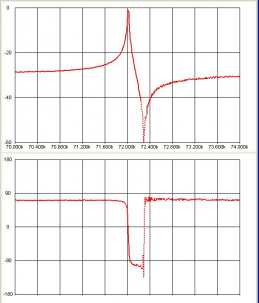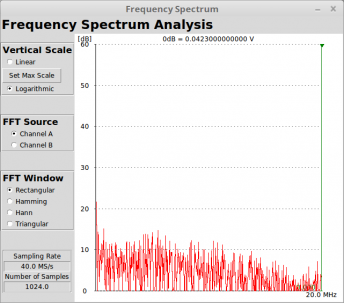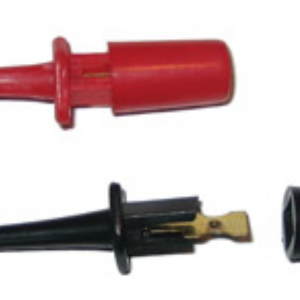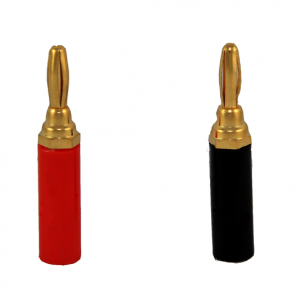CircuitGear MKII
Available in a package including oscilloscope probes and test leads.
Description
Oscilloscope
The CGR-201 CircuitGear oscilloscope is a dual-channel, 40MSample/sec oscilloscope with 10 bit A/D conversion, digital storage and display. Channels A and B are sampled simultaneously and stored in the oscilloscope memory before being sent for display to the host computer. Triggering is accomplished by digital circuitry so it is precise and consistent. Trigger controls include Mode: Auto, Normal, Single-shot, Manual, Source: A or B, and Slope: Positive or Negative. The time and level of the scope trigger point are continuously adjustable by on-screen cursors so that the operator can display the signal before and after the trigger event. On-screen cursors are available to measure amplitude and time interval. The graphical user interface has been designed to be intuitive with convenient access scope amplitude, timebase and trigger controls along with functions such as variable persistence, signal averaging, XY mode, math and instrument calibration. With digital averaging on a repetitive signal the input noise is less than 2mV p-p. For precision and stability the oscilloscope timebase frequency is derived from a crystal oscillator. The vertical preamplifier is gain-switched to optimize the signal-noise ratio and will accept x1, x10 and x100 scope probes.
Function Generator
The CGR-201 Waveform Generator is a powerful, general purpose signal generator with a user interface that makes it easy and convenient to use. All control settings are accessible from button and slider widget controls - there are no menus or sub-menus. The Frequency control is particularly convenient, with a full range of 0.1Hz to 10MHz, linear or log characteristic. The operator can set lower and upper and frequency limits for the slider, such as 20Hz to 20kHz for audio testing. When precision is important, the operator can enter a frequency value directly. The ability to set maximum and minimum frequency and the frequency output, to 0.1Hz resolution makes the generator useful for testing very narrow band filters or for finding resonance in an electro-mechanical system. The Sine, Square, Triangle, Sawtooth and Noise waveforms are built-in. The operator can also create an arbitrary waveform. Tone bursts - one or more cycles of a waveform - are useful in a wide variety of applications: acoustics, audio testing, biomedical apparatus and control system tests. Bursts can be set to any of the 4 repetitive waveforms or an arbitrary waveform, from one to 65535 cycles on, one to 65535 cycles off, and one to 65535 repeats. For example, the operator could create a double burst of square waves that test a microprocessor counter input. Click on the screenshot to see an example. The CGR-201 waveform generator has its own dedicated control panel and can be minimized when not in use. The amplitude and offset are implemented in hardware, so the output waveform is always a full 8 bits.
Arbitrary Waveform Generator
The CGR-201 Waveform Generator has the capability of generating an arbitrary waveform. For example, a car ignition waveform can be used for teaching purposes. An ECG waveform can be used to test a cardiac waveform filter. A SINC pulse can be used for impulse testing. The operator creates the arbitrary waveform using the software tool we provide or a CSV file from a spreadsheet. The arbitrary waveform is a a simple sequence of 2048, 8 bit values. As in the case of built-in waveforms, frequency control is available over full range of 0.1Hz to 10MHz. The operator can set lower and upper and frequency limits for the slider, such as 20Hz to 20kHz for audio testing. When precision is important, the operator can enter a frequency value directly. The amplitude and offset controls also adjust the arbitrary waveform. The ability to set maximum and minimum frequency and the requency output, to 0.1Hz resolution makes the generator useful for testing very narrow band filters or for finding resonance in an electro-mechanical system.
Digital I/O
On the electronic test bench it is often useful to control various digital signals, putting them in a high or low state as required. It's also useful to have indicators to show the state of various digital signals. The outputs can be controlled by SPDT switches and the inputs provided by LEDs. But this is inconvenient: switches bounce and LEDs require significant current, which may require driver transistors. The CGR-201 CircuitGear digital IO section eliminates the need to construct either of those circuits. There are 8 digital outputs that can be controlled from the user interface, and 8 digital indicators that show the state of some digital circuit. (The inputs are compatible with 3V and 5V logic.) The rear panel connector is 10x2 places that mates with a ribbon cable, or you can socket test leads for individual connections. In a student environment, these outputs and inputs can be used to manually control and display digital signals in a test circuit. For example, the digital IO outputs could be applied to the input of a logic gate, and the output of that gate displayed on an CircuitGear digital IO input. A digital IO output could be used as a manual clock for a counter, and the output of the counter displayed on digital IO inputs. The digital IO is particularly useful in connection with automatic test equipment. A designer can write software, using their preferred language and our Open Source API and source code, to send commands to the digital output lines and read the digital input lines. Combined with commands to read oscilloscope data and control the function generator output, it is possible to create an automatic test system at a very modest cost.
PWM Output
A pulse-width-modulated (PWM) signal is a two-level signal where the duty cycle is changed. PWM is the usual control signal for example in switching power supplies and high efficiency motor drives. Or it can be low pass filtered to provide an adjustable output voltage, thereby functioning as a simple D-A converter. The output voltagce is proportional to the average value of the waveform, which changes with duty cycle. The duty cycle can be adjusted from 0 to 100%, and the frequency from 1Hz to 125kHz. The duty cycle remains fixed as the frequency is changed. (This is not true for some waveform generators, where the duty cycle changes with frequency.) Both the duty cycle and frequency can be adjusted by front panel controls and changed from the host via the software API. The figure shows a waveform of 25% duty cycle at a frequency of 1kHz.
Trigger Controls
The CGR-201 single-shot capture and display capability provides the same (or better) features as a moderate-speed storage oscilloscope, at a tiny fraction of the size, weight and cost. The trigger controls make this capability convenient and easy to use. The CGR-201 has trigger signals available for the oscilloscope and tone burst generator. For the oscilloscope, a trigger signal starts a trace capture and displays the trace. For the tone burst generator, a trigger signal generates one iteration of the tone burst signal - which can be one or more cycles of the waveform. In both cases, there are three possible sources for the trigger: a 'manual' pushbutton on the user interface, an external logic signal (via the rear panel connector) and a command generated by the host software. The oscilloscope trigger system will be familiar to anyone who has used a conventional oscilloscope. In addition to the usual 'source', 'polarity' and 'trigger mode' the scope trigger has a cursors for setting the trigger level and position on the screen - the 'T' and 'X' cursors visible in the screenshot. In 'Auto' mode, the scope triggers on a signal if it is available. If not, after a short interval, it triggers a capture event. In 'Normal' mode, the scope triggers on a signal if it is available. If there is no satisfactory trigger signal, the scope waits. In 'Single Shot' mode the scope triggers once and only once for each valid trigger signal. Single shot is reset by actuating the 'Single Shot Reset' button. A 'Manual Trigger' button creates generates a scope trigger signal. This combination of trigger controls makes it straightforward to capture a transient event, such as the bouncing of a mechanical switch as shown in the screenshot. For software control, the software issues a command to 'Arm' the scope. Thereafter, a trigger signal will cause a capture and trace. Manual trigger is also available from software.
Vector Network Analyser
There are many electronic circuits where the amplitude and phase response are important: electronic filters, control systems, audio amplifiers and electro-mechanical systems such as guitar-pickups and loudspeakers. The ability to measure the amplitude response over a range of frequencies is 'Scalar Network Analysis'. The ability to measure both amplitude and phase over a range of frequencies, as in the CGR-201, is referred to as 'Vector Network Analysis (VNA). The amplitude and phase response can be determined point by point at individual frequencies by using the oscilloscope to measure the ratio of output vs input magnitude and phase. This is very tedious to do by hand. The CircuitGear CGR-201 automates this process, at a fraction of the cost of previous instruments. The frequency range is the same as the internal waveform generator: 0.1Hz to 10MHz. The amplitude range is in the order of 60db. The screenshot shows the response of an LC resonant circuit. The resonant peak is at 40kHz. The plot confirms theory: the phase response changes abruptly at resonance from +90 degrees to -90 degrees. The amplitude response increases by 20 db per decade at low frequencies and then shows a Q enhanced response around resonance. The VNA can 'zoom in' on a response, showing amplitude and phase details over a small frequency range. Click on the screenshot to see the response of a piezoelectric crystal around the resonant frequency, 72kHz +/-2kHz. In the classroom and development lab, the VNA eliminates the tedium of manual measurements and allows the operator to concentrate on the shape circuit frequency response. It is straightforward to relate component values to the actual behaviour of amplitude and phase, and compare that to the response predicted by simulation.
Noise Generator
A noise signal is useful in testing of audio equipment, in acoustical measurements such as reverberation time, and in correlation-type algorithms to measure impulse and frequency response. The waveform and spectrum of the CGR-201 noise output are shown in figures noise-waveform.png and noise-spectrum-20MHz.png. The noise spectrum is essentially flat (constant magnitude in a constant bandwidth) up to 10MHz and then decreases, with useful output up to 20MHz. This output, which is said to have a 'white' spectrum, can be filtered by a simple passive filter to create 'pink' noise, useful in audio testing. The CGR-201 noise waveform is generated by a 32 bit shift register configured as a pseudo-random binary sequence (PRBS) clocked at 200 MHz, giving a repetition time of 21 seconds.
Specifications
| Maximum Sampling Rate | 40MS/s |
| Analog Bandwidth | 5 MHz |
| Input Voltage Span | +/-0.25Vpk to +/-25Vpk |
| Input Ranges | 7 ranges in 1:2:5 sequence 2 Hardware Ranges |
| Vertical Calibration | Yes, software |
| Input A/D Resolution | 10 bit |
| Input Impedance | 1Mohm||20pF |
| Timebase Span | 50ns/div to 100ms/div |
| Timebase Ranges | 20 steps in 1:2:5 sequence |
| Trigger | Normal, Auto, Single Shot |
| Trigger Polarity | Rising and falling |
| Trigger Level | On-screen, cursor selectable |
| Pre-Post Trigger Display | On-screen, cursor selectable |
| Readouts | Amplitude and timebase cursors |
| Sample Memory | 4K points/channel |
| Display refresh rate | > 5 updates/second |
| Interface | USB 2.0 |
| Additional Displays | X-Y plot Spectrum Analysis (FFT) Histogram Waveform Math |
| Frequency Range | 0.1 Hz to 10MHz |
| Frequency Resolution | 0.05 Hz |
| Output Amplitude | +/-3V |
| Amplitude Control | Hardware |
| Vertical Resolution | 8 bits |
| Offset Control | Hardware |
| Output Impedance | 50 ohms |
| Standard Waveforms | Sine, Square, Triangle, Ramp, Noise |
| Arbitrary Waveform | 8 bit resolution, vertical and horizontal |
| Noise Spectrum | Flat to 5MHz |
| Pulse Waveform | Variable duty cycle at constant frequency |
| Tone Burst | Supports triggered mode with 16-bit adjustable total cycles, on cycles and off cycles |
| Inputs | 8 bits, 3/5 volt, HCMOS |
| Outputs | 8 bits, 5 volt, HCMOS |
| PWM | Variable Frequency: 0-1.25MHz Variable Duty Cycle: 0-100% |
| Trigger | Trigger Input Trigger Output |
| Magnitude Plotting | 60 dB Range |
| Phase Plotting | +/-180 degrees |
| Frequency Sweep | 0.1 Hz to 10MHz |
| Frequency Stepping | Linear or Logarithmic |

